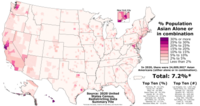
Photo from wikipedia
The Covid-19 pandemic has again emphasized that close collaboration between respiratory physicians and basic scientists is vital. There is a need to bridge the divide between the science and the… Click to show full abstract
The Covid-19 pandemic has again emphasized that close collaboration between respiratory physicians and basic scientists is vital. There is a need to bridge the divide between the science and the clinical application of that science in order to progress novel scientific discoveries and move them into clinical practice. This role has traditionally been played by the clinician-scientist, a person versed in both clinical practice and basic science. However, as science and clinical care have become more complex and highly specialized, younger health professionals have started to eschew this commendable pathway. As a respiratory clinician and basic scientist, respectively, we offer some thoughts on a pathway that is fundamental for this quest. Aspirant clinician-scientists must contend with a multitude of difficulties. Time constraints, rigorous costing of clinical and teaching activities within hospitals and an extremely competitive environment for research funding are all factors that make the life of clinician-scientists challenging. Senior clinician-scientists who can mentor younger physicians are declining in number and are often burdened with onerous administrative duties. Finally, a clinical and research balance is a source of considerable difficulty as we are taught (rightly) that patient care always takes priority. So what is the current situation on the ground for young clinician-scientists in the Asia-Pacific and globally? Circumstances will vary from country to country, but we believe that four principal pathways have evolved and that four ‘phenotypes’ define physician-scientist pathways that facilitate translation of research to patient care (Figure 1). Experience has been that taking on one of the roles as outlined will prompt a testing of both the individual physician and their chosen direction. For example, it may be wise to choose a pathway after consideration of personal preferences, mentoring prospects and available opportunities. The first pathway is suited to people who have a passion for patient care in all its complexities and nuances. This is the territory of the master clinician who skilfully steers patients from disease to health (or stable chronic disease). These practitioners usually become aware of this interest and passion early in their career and tend to avoid involvement in complex and demanding research projects. It is the ‘default’ pathway for most health professionals and can provide a satisfying career—if science and research are not entirely eliminated. Success will depend on keeping an active interest in developments and innovations, reading journal articles, participating in journal clubs, attending conferences (such as the Asia-Pacific Society of Respirology [APSR] Congress) and taking part in underand postgraduate teaching. The second pathway is suited to a person interested in research of daily patient practice. This may involve participating in pharmaceutical or other clinical trials. Epidemiological field studies and longitudinal and long-term research activities are also well suited to this pathway. The young physician or health professional, however, must seek out opportunities and usually will need to affiliate with a research group supported by an externally funded research programme. The advantages are obvious: a deeper understanding of the research area, opportunities to contribute data and information and the chance to present findings at scientific meetings for peer review and debate. The third pathway is contained in the most difficult of careers: a clinician-scientist who maintains high-level clinical involvement in combination with leading/co-leading an independent research programme. Crucial to this pathway is the generation of funding from granting agencies, often in collaboration with basic scientists. For the trainee, this is a particularly challenging option as a prerequisite is often gaining a PhD in their chosen field, involving further study and financial sacrifice when family and other commitments start accumulating. It is often enlightening to consult mentors who have already achieved this level of involvement, before embarking on what is likely to be an arduous journey. However, the long-term benefits are significantly rewarding, and it is the type of career for an individual who is intelligent, curious and determined to have a positive impact. This is a critical pathway that should be encouraged and supported in all countries as it is the conventional and established route for effectively translating basic science to clinical medicine. The final and fourth pathway is for the clinician who comes under the spell of science and research and who decides to pursue this—with minimal clinical involvement. This option is a difficult and consuming career choice that involves obtaining a PhD, overseas research and study. Living from one research grant to the next with attendant financial and career uncertainties is not for the Received: 7 April 2022 Accepted: 14 April 2022
Journal Title: Respirology
Year Published: 2022
Link to full text (if available)
Share on Social Media: Sign Up to like & get
recommendations!